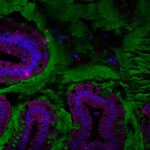Link to HAL – hal-01091920
Link to DOI – 10.1016/j.bmc.2014.10.026
Bioorganic and Medicinal Chemistry, 2014, 22 (24), pp.6924-6932. ⟨10.1016/j.bmc.2014.10.026⟩
The Glaser-Eglinton reaction between either two C or N propargylglycine (Pra or NPra) amino acids, in the presence of copper(II), led to cyclic hexa- and octapeptides constrained by a butadiyne bridge. The on-resin cyclization conditions were analyzed and optimized. The consequences of this type of constraint on the three dimensional structure of these hexapeptides and octapeptides were analyzed in details by NMR and molecular dynamics. We show that stabilized short cyclic peptides could be readily prepared via the Glaser oxidative coupling either with a chiral (Pra), or achiral (NPra) residue. The 1,3-butadiyne cyclization, along with disulfide bridged and lactam cyclized hexapeptides expands the range of constrained peptides that will allow exploring the breathing of amino acids around a β-turn structure.


